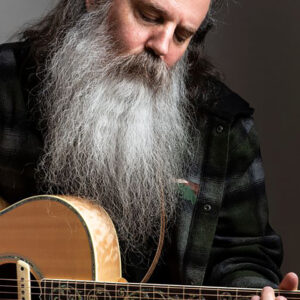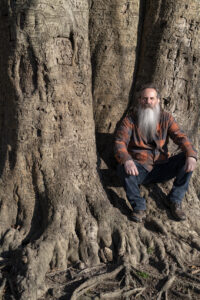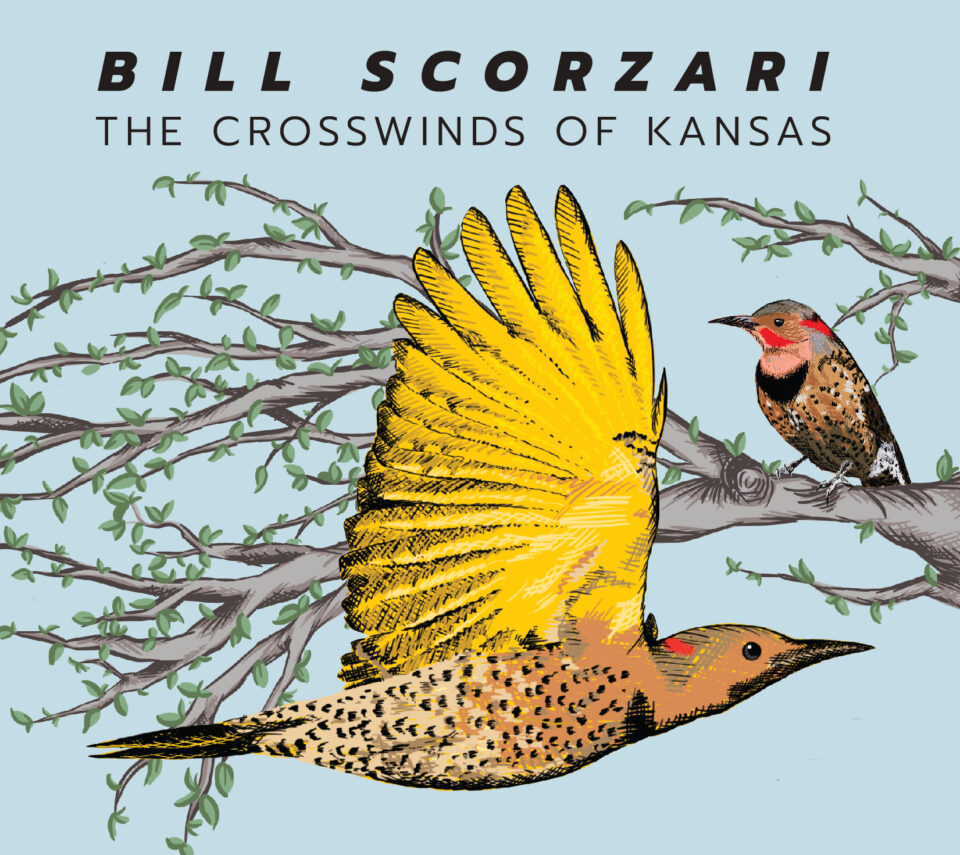There is a texture to the songs and sound of Bill Scorzari that defies description. With a voice called “gravelly” or “raspy,” he is likened to Kris Kristofferson or Bob Dylan, though he thinks comparisons to Sam Baker are closer to the truth.
“Not so much the voice-but partly the voice—but the approach to the music and lyrics and delivery,” he explained. “Before that, it was mostly like Tom Waits or even Bruce Springsteen, which again leads in the right direction, but it’s not the same.”
With his staying power, it’s conceivable that eventually other singer-songwriters will be told,
“You know, you sound a little bit like Bill Scorzari.”
Scorzari started gathering the seeds of songs for his new album The Crosswinds of Kansas on his return trip from the west coast to New York after coming off his Now I’m Free tour in 2019. While the songs came one by one, he began to consider purposefully and deliberately how they worked together for his next project. He says songs written in a particular period work together like photographs from the same time.
In “I-70 East,” the first track on the album—and the first single released from the project—Scorzari brings listeners along on the road trip through Kansas: “through . . . Hays and through Salina, and then through Lawrence” as he deals with “another love leaving me lost.”
He also found that “The Broken Heart Side of the Road,” penned earlier and the second single from the album, fit with arc of the project.
Much of the work on The Crosswinds of Kansas was born in Scorzari’s home studio that he had been working on for years “between other things and not in a very focused way; when I had some spare time and was in the mood for that kind of work,” he explains. Once he returned home from the Now I’m Free tour, he started writing songs for a new record, expecting then to go to Nashville to record it. Then COVID hit, and he couldn’t go anywhere, particularly living in New York, which remained locked down for a long time.

Scorzari said he looked around and said, “You know, I have the studio very close to being done, so let me finish it” and he did just that. He completed the construction, got more gear he needed to finish the studio and started to record in May of 2020.
“I just kept going,” he said. “I was thankful to be able to do that. Without that opportunity to occupy me, I would have really had a much more difficult time with the isolation.” He noted that he did some live streaming, but it was not the same as live performances. “It was,” he said, “difficult to maintain a positive perspective, so I was glad to have that project.” When vaccines were introduced and began to have an effect on the pandemic, Scorzari went to Nashville and finished the album, which he co-produced with Neilson Hubbard.
In Nashville, recording at Skinny Elephant Recording with engineer Dylan Alldredge, they added the instrumentals by a number of stellar musicians-—Eamon McLoughlin on fiddle, Will Kimbrough on mandolin, Michael Rinne on bass, Brent Burke on dobro, who had played on his last three records, and more. He also had Marie Lewey and Cindy Richardson Walker of the Shoals Sisters, who had sung on his second record, Through these Waves, come into the Nashville studio from Alabama.
Even Scorzari finds it difficult to categorize his sound. “There’s a lot of singer-songwriter,” he said, “there’s country, a touch of bluegrass, some blues, some folk. It’s good we have the Americana title because so much fits under that, but it may be more of a nondescript.” For this album, though, he found some of the songs have an upbeat feel—even when the lyrics are not necessarily upbeat. He said he usually finds the tempo and mood of his music more congruent with the lyrics, but on Crosswinds of Kansas, “just the opposite happened without even thinking about it at all.” The sound that resulted is heartbreak with an air of hopefulness or optimism.
Scorzari’s songs strike a balance between poetic elements and a conversational quality. His creative use of internal rhyme and repetition in such songs as “All Behind Me Now,” play to the ear of the listener while maintaining a natural rhythm.
“It’s actually something that’s intentional,” said Scorzari. “When I’m writing a song, the first part of the process is to sit down and figure out what exactly I want to write. Sometimes I don’t really know; other times, I do.” Once the ideas appear, he says, he develops the song, getting an idea of what he wants to say, then he works on phrasing and basic rhymes, moving verses around.
“Sometimes the first verse will end up being the fourth verse, and I’ll steal lines from one verse to move to another, but once the ideas are there, I think about how I would say this in a normal conversation; what’s the normal way of speaking? It’s a way to avoid writing something that sounds contrived. I want the focus to be off the rhyme and onto the meaning.”
The deliberate timing of the songs adds a layer as well. In the opening lines of “Inside My Heart,” he sings, “You don’t like flowers. . .” pausing just a beat before adding, “or me, waiting at your door when you’re not home,” adding subtle nuances through the delivery.
Scorzari finds some inspiration for his songs in spiritual, introspective texts, which he says have been a focus for years. A strong influence on this album as well came from the road trip for his last album tour, sometimes driving ten to fifteen hours from one place to the next through sparsely populated areas.
“Driving through parts of Wyoming, there was just nothing but beautiful country, nature, and the highway, so I started writing haiku,” said Scorzari. “I’d been driving for hours and hours, and it was starting to get late, but thankfully, I had a full tank of gas when I started the drive but there was not a house, not a telephone pole, not a shack, not a gas station not a building–nothing but the highway. I might see bison or a couple of semis coming the other way within three hours. It got so dark I could only see what the high beams showed me on the highway. Then the full moon came up over the mountains, throwing patches of light and shadows. I thought, ‘Oh man! I’m on my own private planet here.’
“A month later, on the way back home, heading east through Colorado, there was the full moon again, and to occupy my time as I was driving, I was composing haikus, so I wrote:
old friend in the sky
having no light of its own
still shining brightly
“I took a lot of those haikus and started writing a song with them. I realized that I needed a fourth line to make them work as lyrics, so I had to wreck the haiku form by adding a 7-syllable fourth line to at least keep it consistent. I got eight verses and two choruses, and it wound up being the last song on the album.”
The resulting song “Tryin’, Tryin,’ Tryin’, Tryin,” that closes the album is infused by a Navajo influence that resonates through the whole album. Scorzari explained its origin:
“Traveling through Utah, I stopped at Salt Wash in the Moab Desert and found that I couldn’t leave there, it was so incredibly beautiful. I had started learning how to play the Native American flute about a year earlier and had brought it with me. I climbed down the mountain side and sat there playing the flute and taking in the nature. Finally, after about four hours, I realized I needed to get back on the road to get anywhere before a reasonable hour.”

When he got back to New York and was playing around with the haiku-inspired verses, he thought of putting a Native American flute part on the song, but the one he owned was in the wrong key. Researching flute makers, he found a shop close to the place in Utah where he had his transformative experience.
Scorzari played the song for the flute maker and worked with him, deciding on materials that would produce the sound he wanted and designing at the decorative, symbolic artwork for the two flutes that would be created for this song. In the process of one conversation, Scorzari learned that Ty Allison, the man who would create the two flutes, was Navajo. The project, Scorzari said, had come full circle. He began to wonder if he could add Navajo lyrics to the song to celebrate and share this culture. When he asked about finding someone to translate his lyrics, he was then introduced to Ty.
Scorzari said, “I wasn’t even sure if I was allowed to ask him to do that because, to me, it’s something sacred, but I was happy to discover that Ty was also excited about it.” Ty and his friend Caleb translated the modified haikus into eight verses in Navajo, though not a direct translation, since some words don’t translate back and forth. For example, said Scorzari, his line “Wyoming is far from my home” translates in Navajo to something like “Wyoming is way over there.” occasional disparity of the translation, says Scorzari, added another dimension to the song,
The Navajo men also helped him learn to pronounce the lyrics correctly, providing a recording by Caleb and a written phonetic translation. After spending a couple of weeks and finding the challenge incredibly difficult, Scorzari says he thought, “Oh man, I had these guys do all this work, and I really want to do this, but I don’t want to do it in a bad way.” He gathered his courage and called Allison to confess he was having a tough time. Allison told him, “Bill, Navajo is probably the most difficult language for an English-speaking person to learn.”
Scorzari says he was reminded of the Navajo code talkers. Reassured that the difficulty was inherent in the language, Scorzari decided to keep working with their help. He admits that the effort—and his emphasis on this song—may be disproportionate, since it is one song out of thirteen on the album, but the spirit spilled over into the other songs. He wound up playing the Native American flute on one of the other tracks “Inside My Heart” and brought in other Native American instruments for the Nashville recording sessions, including a buffalo hide PowWow drum and several horse and moose hide hoop drums, turtle shell, moose and bear hide shakers and rattles, as well as bells, chimes and more. When he mentioned the instruments and his ideas for them to Hubbard, who co-produced the album and also played percussion on the album, he was excited about experimenting with them in the studio too. Scorzari says, “There’s something really special about these drums. After using them in the studio, Neilson wound up buying one of the Navajo style drum beaters for himself that he had liked using on this album.
The resulting recording is evidence of a labor of love for Scorzari, a personal challenge to make sure he got it right, honoring the culture of the Navajo people working with him to give the music a real legitimacy. Scorzari said his voicing of the Navajo lyrics of “Tryin’, “Tryin’, Tryin’, Tryin’” is more of a northern style of singing or narration.
“There’s also a southern style of singing, which has higher pitched and more intense vocalizations that I also initially wanted to add to the song, but when I ran out of time and Ty offered to send me a recording of himself doing some traditional Navajo chanting later than evening, and after I heard what he sent me, I knew it would be perfect for the song. It ended up being the last sounds heard on the album.
Another element adding authenticity to the album is the sense of place–references to particular Kansas towns, the eleven switchbacks along the trail to the top of Multnomah Falls in Oregon, the Moab and Salt Wash in Utah.
Scorzari explains, “I just want it to be real, to be honest and hopeful. I approached it that way, with the aim that it will be relatable and will resonate with people.” The threads that run through the songs are so evocative that listeners who haven’t been to those locations will identify with places of their own.
With The Crosswinds of Kansas complete, Scozari is already writing for the next project and tentatively planning a tour to promote the album. With COVID still a factor, he wants to proceed carefully and deliberately. Not only does a tour offer inspiration for new songs, but he looks forward to the people he encounters. On the Now I’m Free tour in 2019, he says, “everywhere that I went–I’d say at 95% of the shows–someone from my past showed up all over the country–somebody in Vermont, someone in upstate New York, in Washington, Oregon, Chicago. It got to the point where I was heading out on a ten-hour drive to the next show wondering, ‘Who’s going to show up this time?’ In Washington, my best friend from second grade showed up. I hadn’t seen him since like junior high school.”
At the release of The Crosswinds of Kansas tour, Scorzari may have gathered enough inspiration from encounters and sights along the road to be ready to head back to the Nashville studios.

